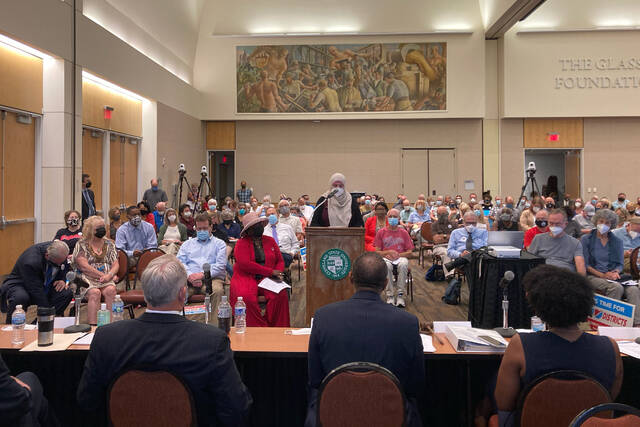

COLUMBUS, Ohio (AP) — The powerful new redistricting panel in Ohio entered an hours-long recess Wednesday, signaling that chances of agreeing on new 10-year maps of state legislative districts by a midnight deadline are slim.
The Ohio Redistricting Commission’s pause came as Republicans and Democrats appeared stalled on any plan both parties can agree upon. Without the votes of both the panel’s Democratic members, any district boundaries the 7-member panel approves can only last four years.
“We’re recessing so that we can continue some consultations that are going on, some work that is being done on the map for the finalization that needs to be done,” said Republican House Speaker Bob Cupp, the panel’s co-chair, “as well as any changes that might be considered.”
What changes were being discussed were not immediately clear.
Democratic state Sen. Vernon Sykes, the panel’s other co-chair, said his hope for a compromise was waning.
“To have a bipartisan plan, you need the will to do it, and I don’t see that at this point,” he said.
He said he had spoken to all four Republican commission members and was given “no indication that they would support” maps Democrats have brought forward as an alternative to those offered by the GOP. Republicans’ map of Ohio’s 99 House districts was given an “F” grade by one anti-gerrymandering group.
Republican Gov. and commission member Mike DeWine spoke at length with Sykes before Wednesday’s meeting began. The governor did not rule out that agreement on a 10-year map could be reached.
“I’m always an optimistic person,” he told a reporter while departing the room.
Only two of the panel’s five Republicans would need to side with Democrats to accomplish the 4-3 vote needed for a 10-year map. The commission’s GOP members are DeWine, Cupp, Senate President Matt Huffman, Secretary of State Frank LaRose and Auditor Keith Faber.
Public statements by LaRose and Faber have suggested they might be amenable to supporting Democrats, but a statement by Ohio Republican Chair Bob Paduchik on Tuesday suggested the political divide remains wide.
“The biggest lie in Ohio politics today is the notion that the Ohio Citizens’ Redistricting Commission is a group of voting rights activists instead of a Democrat advocacy organization,” he said in a statement. “The next biggest lie is the idea their ‘unity map’ is anything other than a Democrat gerrymander of Ohio legislative districts.”
Ohio is using a new redistricting process for the first time this year that was approved by voters through state ballot issues in 2015 and 2018. The new system is meant to combat partisan gerrymandering, or the drawing of districts for partisan gain.
The Ohio electorate is roughly 53% Republican and 45% Democratic, experts estimate. Yet, under the current GOP-drawn maps, Republicans control 64% of Ohio House seats and 75% of Ohio Senate seats.
An Associated Press analysis found that Ohio’s maps are among the nation’s most gerrymandered, during a period when Republicans won more seats than would have been expected based on the percentage of votes they received.
The separate process for redrawing congressional districts is running concurrently to the legislative map-making process. Ohio lost one congressional seat due to lagging population growth recorded in the 2020 Census, which will give the state 15 rather than 16 seats for the next 10 years.

